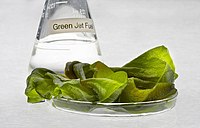
Photo from wikipedia
Municipal wastewater reverse osmosis concentrate (ROC) poses health and environmental risks on its disposal as it contains nutrients and harmful organic compounds at elevated concentrations. This study compared a freshwater… Click to show full abstract
Municipal wastewater reverse osmosis concentrate (ROC) poses health and environmental risks on its disposal as it contains nutrients and harmful organic compounds at elevated concentrations. This study compared a freshwater microalga Chlorella vulgaris and a marine microalga Nannochloropsis salina in suspended and alginate-immobilised cultures for batch and semi-continuous treatment of the ROC. The immobilised algae gave comparable nutrient removal rates to the suspended cells, demonstrating immobilisation had no apparent negative impact on the photosynthetic activity of microalgae. Semi-continuous algal treatment illustrated that the microalgae could remove significant amounts of nutrients (> 50% and > 80% for TN and TP, respectively), predominantly through algal uptake (> 90%), within a short period (48 h) and generate 335–360 mg DCW L-1 d-1 of algal biomass. The treatment also removed a significant amount of organic matter (12.7–13.3 mg DOC L-1 d-1), primarily (> 65%) through the biotic pathway.
Journal Title: Environmental Science and Pollution Research
Year Published: 2020
Link to full text (if available)
Share on Social Media: Sign Up to like & get
recommendations!